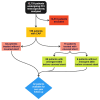A Novel Strategy for Emergency Treatment of Coronary Perforations by Placing a Drug-Eluting Stent before Sealing off the Leakage with a Covered Stent to Improve Long-Term Outcomes in Patients with Coronary Artery Perforations
- PMID: 38003857
- PMCID: PMC10672714
- DOI: 10.3390/jpm13111542
A Novel Strategy for Emergency Treatment of Coronary Perforations by Placing a Drug-Eluting Stent before Sealing off the Leakage with a Covered Stent to Improve Long-Term Outcomes in Patients with Coronary Artery Perforations
Abstract
We aimed to investigate the safety, feasibility, and long-term results of drug-eluting stent implantation before covered stents for treating coronary artery perforation (CAP). Between 2015 and 2020, 12,733 patients undergoing percutaneous coronary intervention (PCI) were retrospectively analyzed. The primary endpoint was 1-year target lesion revascularization (TLR), whereas secondary endpoints included the rate of major adverse cardiac and cerebrovascular events (MACCE) and all-cause death at 1 year. A total of 159 patients with CAP were identified during the study period, of whom 47.2% (n = 75) were treated with a covered stent (CS group) because of complex and/or severe CAP and 84 (52.8%) without (non-CS group). In the majority of patients, emergency drug-eluting stent placement before covered stent implantation was feasible (n = 69, 82%). There were no significant differences among patients treated with or without a covered stent in terms of primary or secondary clinical endpoints: a similar rate of TLR (18.67% vs. 21.43%, p = 0.6646), MACCE (25.33% vs. 22.62%, p = 0.6887), and 1-year mortality (12.00% vs. 11.90%, p = 0.9853) were identified comparing cases with covered stent implantation and without. In conclusion, our study implicates that the use of covered stents for sealing coronary perforation might not impact the 1-year clinical outcome if used properly. Moreover, the emergent use of drug-eluting stents before covered stent implantation in CAP is a safe and effective method to avoid target lesion revascularization in patients treated with covered stents.
Keywords: coronary artery disease; covered stent; perforation.
Conflict of interest statement
Kambis Mashayekhi reports consulting/speaker/proctoring honoraria from Abbott Vascular, Abiomed, Asahi Intecc, AstraZeneca, Biotronik, Boston Scientific, Cardinal Health, Daiichi Sankyo, Medtronic, Shockwave Medical, Teleflex, Terumo. Mohamed Ayoub reports consulting/speaker/proctoring honoraria from Asahi Intecc, Abbott Vascular, Biotronik, Boston Scientific, Medtronic, Teleflex, and Terumo. Noé Corpataux acknowledges funding from the European Society of Cardiology through an ESC Training Grant and a Gottfried & Julia Bangerter-Rhyner Foundation Grant. These Grants support his fellowship in Germany. The other authors declare no conflict of interest.
Figures
Similar articles
-
Clinical Outcomes of Self-Made Polyurethane-Covered Stent Implantation for the Treatment of Coronary Artery Perforations.J Interv Cardiol. 2021 May 17;2021:6661763. doi: 10.1155/2021/6661763. eCollection 2021. J Interv Cardiol. 2021. PMID: 34104120 Free PMC article.
-
Sealing of Coronary Perforations With a Second-Generation Covered Stent Graft - Results From the PAST-PERF Registry.Cardiovasc Revasc Med. 2021 Apr;25:20-26. doi: 10.1016/j.carrev.2020.10.012. Epub 2020 Oct 23. Cardiovasc Revasc Med. 2021. PMID: 33132086
-
Intravascular ultrasound to guide percutaneous coronary interventions: an evidence-based analysis.Ont Health Technol Assess Ser. 2006;6(12):1-97. Epub 2006 Apr 1. Ont Health Technol Assess Ser. 2006. PMID: 23074482 Free PMC article.
-
Meta-analysis study comparing percutaneous coronary intervention/drug eluting stent versus coronary artery bypass surgery of unprotected left main coronary artery disease: Clinical outcomes during short-term versus long-term (> 1 year) follow-up.Medicine (Baltimore). 2018 Feb;97(7):e9909. doi: 10.1097/MD.0000000000009909. Medicine (Baltimore). 2018. PMID: 29443766 Free PMC article.
-
Outcomes of patients who undergo percutaneous coronary intervention with covered stents for coronary perforation: A systematic review and pooled analysis of data.Catheter Cardiovasc Interv. 2020 Dec;96(7):1360-1366. doi: 10.1002/ccd.28646. Epub 2019 Dec 18. Catheter Cardiovasc Interv. 2020. PMID: 31850685
References
-
- Kinnaird T., Kwok C.S., Kontopantelis E., Ossei-Gerning N., Ludman P., deBelder M., Anderson R., Mamas M.A. Incidence, Determinants, and Outcomes of Coronary Perforation During Percutaneous Coronary Intervention in the United Kingdom Between 2006 and 2013: An Analysis of 527 121 Cases From the British Cardiovascular Intervention Society Database. Circ. Cardiovasc. Interv. 2016;9:e003449. doi: 10.1161/CIRCINTERVENTIONS.115.003449. - DOI - PubMed
-
- Hirai T., Nicholson W.J., Sapontis J., Salisbury A.C., Marso S.P., Lombardi W., Karmpaliotis D., Moses J., Pershad A., Wyman R.M., et al. A Detailed Analysis of Perforations During Chronic Total Occlusion Angioplasty. JACC Cardiovasc. Interv. 2019;12:1902–1912. doi: 10.1016/j.jcin.2019.05.024. - DOI - PubMed
LinkOut - more resources
Full Text Sources
Miscellaneous




